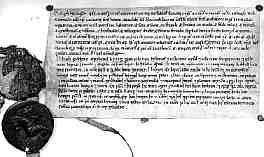
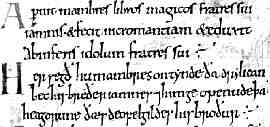
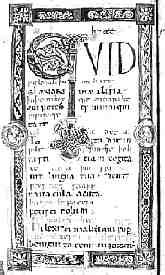
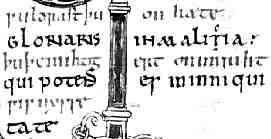
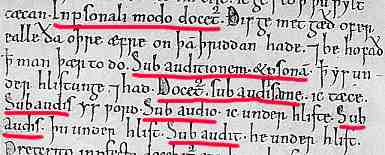
If you are looking at this page without frames, there is more information about medieval writing to be found by going to the home page (framed) or the site map (no frames).
| Bilingual Texts | ||||
| The presentation of bilingual texts could be organised in different ways. When both English and Latin texts were present, different scripts were used for each. Caroline minuscule or protogothic for was employed Latin text and insular minuscule for English text. | ||||
 |
Charter of Henry I to the monks of Christ Church Canterbury, from 1123 (British Library, Campbell Chart. xxi 6), by permission of the British Library. | |||
| In this bilingual charter the complete text appears in two blocks, first the Latin text, then the English. The handwriting is actually very similar for the two sections, differentiated mainly by characteristic letters such as g and the addition of the special letters for th in the English version. The Latin script might be descibed as a protogothic, as the letters are becoming angular, but then again you might describe it as a late English Caroline minuscule. | ||||
| The first words of the Latin and English sections of the charter. | ||||
| In an 11th century copy of a late antique work on the Marvels of the East, the Latin and English versions alternate paragraph by paragraph. | ||||
 |
A Latin then an English paragraph from the work (British Library, Cotton Tiberius B V), by permission of the British Library. | |||
| The Caroline minuscule of the Latin has the English characteristic of wedged ascenders on letters like b and l. The English version uses distinctive forms of d, g and s as well as the th symbol. | ||||
| The first words of each section show some of the characteristic letters of each script. | ||||
| The Winchcombe Psalter, from the early 11th century, alternates Latin and the English translation line by line. | ||||
 |
The image on the left shows the layout of the page (Cambridge MS Ff 1.23, f.88v), by permission of the Syndics of Cambridge University Library and the British Library. The lower image shows a detail of the text. | |||
 |
||||
| After the decorative Q the first word is in square capitals. The first line of Latin is in uncials and then it proceeds to Caroline minuscule with a few extra flourishes, as in the word potens in the middle line. The English is written in a different coloured ink. The English text could be described as a gloss, as found in other Anglo-Saxon liturgical manuscripts, but it is not a later addition. It is part of the original page design and apparently of equal weight with the Latin text. | ||||
| Finally, just to show how a single scribe could thoroughly integrate and contextualise these scripts, a segment from Aelfric's Latin Grammar of the 11th century shows different letter forms for the Latin words embedded within the Old English text. | ||||
 |
A segment from Aelfric's Latin Grammar (Cambridge University Library, MS HH.1.10, f.49b). The lurid red underlining, only on the digital version you will be pleased to know, shows the Latin words in the text. (From New Palaeographical Society 1908) | |||
| The examples show not only that scribes could produce more than one style of writing to suit the circumstances. It also indicates that the script style could have a social significance. How you write is important in relation to what you write. The use of English as a language in the different contexts of these examples makes a statement about the significance of the vernacular. The use of a different script for the English text gives emphasis to that statement. English is asserting itself as a language of the literate, even when they are using it to study Latin. | ||||
|
|
||||
|
If you are looking at this page without frames, there is more information about medieval writing to be found by going to the home page (framed) or the site map (no frames). |
||||